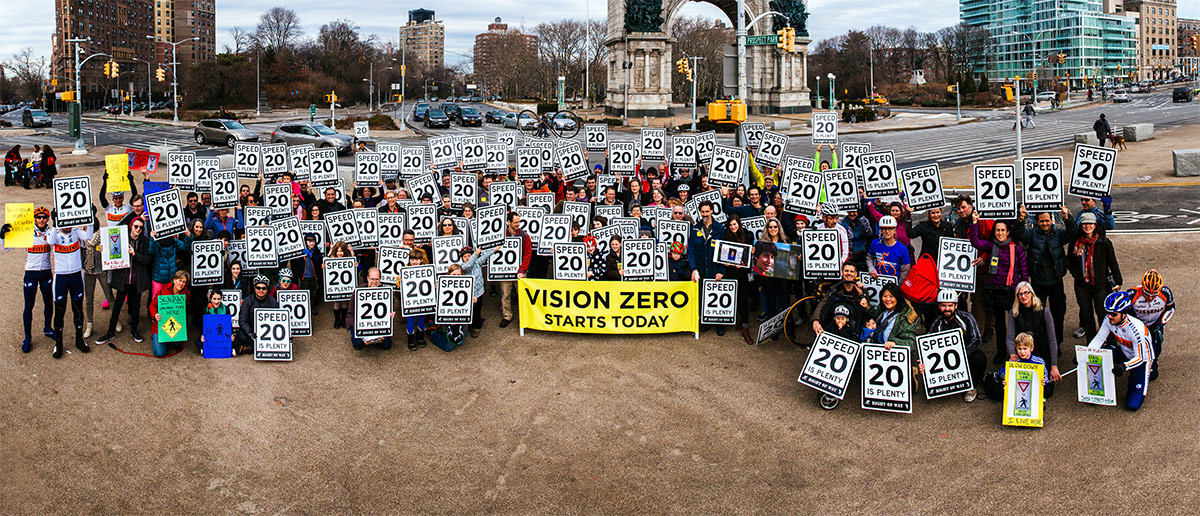Vision Zero is a hot topic these days. News outlets are writing about it, cities are adopting it, and people are throwing the term around left and right. Boiled down, the concept seems simple: Vision Zero is an approach to road safety and has the ultimate goal of preventing all traffic deaths and serious injuries. It is the application of these words that is harder to grasp. The more I heard about Vision Zero, the more questions I had. So I turned to an expert, Leah Shahum, director of the Vision Zero Network, for which PeopleForBikes provided startup funding. She helped me understand Vision Zero more thoroughly, explained why bike riders should be on board with it and taught me that it’s not such a radical idea after all.

What is Vision Zero?
As Shahum explained to me, Vision Zero is a completely new approach to the way we think about safety on our streets and is different from prior approaches in three main ways. “First, Vision Zero acknowledges that traffic deaths and severe injuries are preventable,” she explained. “Second, Vision Zero brings together diverse—and necessary—stakeholders to address a complex social problem. And finally, Vision Zero is a data-based approach.” Shahum described previous attempts at street safety as a “whack-a-mole game.” In comparison, with Vision Zero, “communities are starting to treat traffic safety as a public health issue and using data to make decisions.”
One lingering confusion I had about Vision Zero was that no matter how safe a street might be, people can still make mistakes that lead to traffic incidents. Shahum explained that mistakes will still happen, but we can create systems that don’t let them turn into fatalities.

Is it catching on?
Want proof that Vision Zero is en vogue? “In just the past 18 months, mayors of major cities including New York, San Francisco, Washington D.C., and Seattle have committed to Vision Zero goals,” Shahum said. More are on the way.
Shahum explained that transportation systems are at odds with priorities for improved health, sustainability, equity and economic well-being, and nowhere is this felt more than in cities. By working toward Vision Zero in collaboration with leader cities, Shahum aims to help them test ideas and learn from each other, developing successful strategies more quickly.
Adopting Vision Zero goals is not as simple as giving a speech and calling it a priority, cities must show that they are all in. “It’s critical that there is political commitment at the very highest levels in the city,” Shahum said. Cities must also have “clear goals and measurable strategies within a specified timeline,” she added. What makes Vision Zero different from previous safety strategies is that cities are finally saying that safety is the priority no matter what.

What’s in it for bikes?
The first few times I heard about Vision Zero I thought it was all about cars and pedestrians. Shahum cleared up that misperception. Vision Zero is about safe streets, which will benefit drivers, pedestrians, and bicyclists alike, and Shahum sees Vision Zero as a way to bring us all together.
“People on bikes can sometimes be characterized as singularly-focused, or only interested in bike issues,” she said. “I think bicyclists can help lead the way toward Vision Zero and also show how much we care about the safety of the entire community.”
If all road users are safer, Shahum explains, bike riders will get more respect and more people will be drawn to use bikes for transportation and recreation. These new users could include families, many of whom currently don’t ride together because they’re afraid.
“If U.S. communities follow the lead of successful Vision Zero cities in Sweden, Germany,” Shahum theorizes, “we’ll offer families more fun, affordable and easy ways to move around together.”
Is it too radical for the United States?
For many, myself included, the biggest question about Vision Zero is if it is even possible. Shahum was initially in that camp herself. “I was originally concerned that setting such a high—or in this case, low—goal would not be taken seriously,” she explained, “but now I realize that only by setting such a strong, clear goal can we change our thinking about safe mobility.”
Vision Zero gets peoples’ attention, it makes us think, and it causes us to envision a future in which zero traffic deaths and serious injuries is the reality. We need to see each death and injury as preventable, so zero is really the only option.
I still wondered if it was a radical idea, something borrowed from Europe that would have a hard time getting mainstream support in the U.S. Shahum has heard this before. “I usually explain to people that Vision Zero is about making sure that they and their families and their friends have the right to move around their communities safely without being endangered needlessly.” When you look at it that way, it’s hard to disagree with Shahum’s final thought: “not so radical, huh?”
[Editor’s Note: This article was cross-posted from PeopleForBikes. To learn more about VIsion Zero, visit the Vision Zero Network website and read this recent PeopleForBikes blog post about spreading Vision Zero the way we have spread bike lanes. Top image: A Vision Zero rally in Brooklyn, New York, by Dmitry Gudkov / Flickr.]


